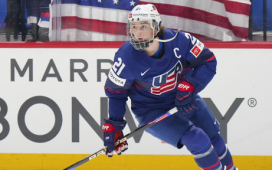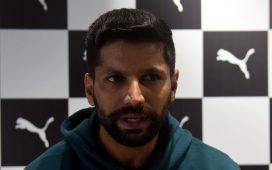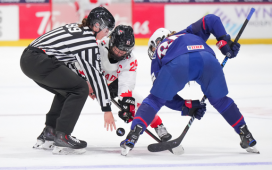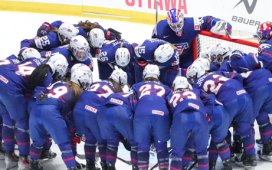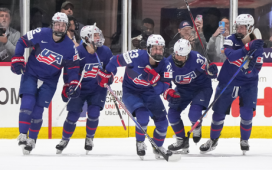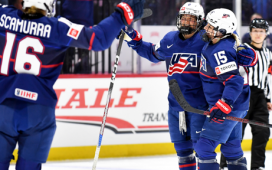Who’s the next player to join Alex Ovechkin in the NHL’s 700-goal club?
The short answer is, probably nobody. There’s a reason Ovechkin is set to become just the eighth player in NHL history to score 700 goals. It’s hard to do. Very, very hard to do.
Gordie Howe was the first NHL player to reach 700 goals in 1968 and Jaromir Jagr became the seventh player to do so in 2014. In the 46 years in between – including the league’s highest-scoring quarter-century from the early 1970s through the mid-1990s – just five other players reached the milestone. It’s hard to. Very, very hard to do.
In fact, you could argue that Ovechkin has a better chance of beating Wayne Gretzky’s all-time record of 894 goals than anyone has of approaching 700 goals in the next, say, 15 or 20 years.
A better question might be to ask who’s the next player to join the NHL’s 600-goal club. And the short answer might be the same: probably nobody. But it wasn’t so long ago that Gretzky’s record appeared absolutely untouchable, and here’s Ovechkin raising the possibility.
So, with a stick tap to Ovechkin’s 700-goal glory, here’s a look at 14 current NHL players – ranked by their career goal total to date – who we’re saying maybe, just maybe, have a chance at the 700-goal club:
Sidney Crosby, Pittsburgh (32 years old, 458 goals)
If you take 40-year-old Patrick Marleau (561 goals) out of the mix, Crosby is Ovechkin’s closest pursuer – and he’s a long ways back, nearly 250 goals off the pace. The Penguins superstar looks good for 500 goals and 600 is certainly within range. But 700? Even for Crosby, that’s a stretch. Let’s make the generous assumption that he stays mostly healthy and plays seven more seasons. He’d need to average almost 35 goals a year to get to 700. Possible? Sure. But highly unlikely.
Steven Stamkos, Tampa Bay (30 years old, 422 goals)
Also unlikely, but a better chance than Crosby. Stamkos is a couple years younger and, more importantly, more of a shooter than Crosby. Plus, he’s fully recovered from devastating injuries that cost him most of the 2013-14 and 2016-17 seasons, and he’s an integral part of a loaded Lightning team that looks like a high-flying contender for the foreseeable future. If he finishes this season with 430 goals, Stamkos would need to average 30 goals a year for the next nine seasons. Or, if he averages 40 goals a season for the next five years, he’d be around 630 goals at age 35 – at that point, another 70 goals over the next three or four seasons seems feasible.
John Tavares, Toronto (29 years old, 342 goals)
He’s less than halfway to 700 goals nearly 11 seasons into his NHL career, and it’s hard to imagine he’s going to play another 11 seasons and score at a higher rate. But if you’re a Leafs believer (hello? is this thing on?), you might put Tavares down for 45 goals a season for the remaining five years of his contract. That’s 225 goals, plus the approximately 350 he’ll have by the end of this season, which would put him around 575 goals at age 34. This is a best-case scenario, and he’d still need to pump in 125 goals in his mid-to-late 30s. Put him below Crosby in the “highly unlikely” category.
Nikita Kucherov, Tampa Bay (26 years old, 217 goals)
If you pro-rate his 29 goals in 59 games this season, Kucherov has averaged 40 goals a season for the past four years. That’s very impressive, but he’s got to keep it going – and then some – to approach 700. Even if Kucherov somehow reels off 10 more 40-goal seasons, he’d be around 625 goals at age 36. He’d still need 75 goals in his late 30s. That’s the stuff of Jagr.
Nathan MacKinnon, Colorado (24 years old, 188 goals)
Let’s say the Avs’ Hart Trophy contender gets hot down the stretch and scores 12 more times to finish the season with an even 200 goals. He’d still need 500 more goals. But if you want to get crazy, here’s how it could happen: a dozen 40-goal seasons starting next year would put MacKinnon at 680 at age 37 (he turns 25 in September). If he pulls off that incredibly implausible feat, then yeah, he’ll probably stick around and try to score 20 more.
David Pastrnak, Boston (23 years old, 175 goals)
We’re into the territory of “young players who have scored a lot of goals early in their career, so if they can keep it going for a decade or so and everything goes right, 700 goals is not completely unfathomable.” And that’s about as good a chance as you’re going to get. It’s not completely nutty to project Pastrnak averaging 40 goals per season for the next 10 years, maybe even a little more. Say he scores 10 more times this season, another 400-plus goals would put him around 600 at age 34 (he turns 24 in May). Could he score another 100 in his mid-to-late 30s? Yes, theoretically, he could. But he’s got to score 425 goals over the next decade first. Get back to me in 2030 and we’ll see where Pastrnak is at.
Leon Draisaitl, Edmonton (24 years old, 160 goals)
He’s big and built for the long haul, he’s got Connor McDavid as a teammate (and often a linemate) and he’s already got a 50-goal season to his credit. Like Pastrnak, it’s reasonable to put Draisaitl down for decade’s worth of 40-plus goal seasons. So if he’s at, say, 170 goals at the end of 2019-20, another 430 goals over the next 10 years would put him in the 600 range at age 35 (he turns 25 in October). In a perfect world, it’s possible to get to 700 from there. That’s all he needs: a perfect world. Not asking too much, is it?
Connor McDavid, Edmonton (23 years old, 158 goals)
To this point in his career, he has almost twice as many assists (295) as goals. Obviously he can score – he’s got two 40-goal seasons and he’s working on a third – but McDavid is more of a playmaker. Then again, he’s Connor freakin’ McDavid, so if he focuses more on putting the puck in the net himself rather than passing off, maybe Ovechkin should be checking the rearview mirror. A good finish to this season plus 10 more 40-goal campaigns would put him around 570 at age 33. It’s … possible.
Auston Matthews, Toronto (22 years old, 154 goals)
The Leafs’ gunner has averaged 40 goals a year over his first four seasons. He’s got plenty of offensive support in Toronto. An uptick to 45 per season for the next 10 years would put him at 600-plus entering his age-33 season. Obviously he’s got to stay healthy, but we’re making that (gargantuan) assumption for everyone on this list. Again, I don’t think any NHL player is going to hit 700 goals in the next 20 years, but given his age and productivity to this point, Matthews looks like the best bet.
Patrik Laine, Winnipeg (21 years old, 135 goals)
The Jets sniper is a pure goal-scorer and his one-timer is reminiscent of Ovechkin’s signature blast. Laine got off to a great start to his career, with 80 goals as a teenager over his first two seasons. He’s going to be closer to 60 goals over the past two seasons – which is fine and good, but he needs to be trending the other way to enter the 700-goal conversation. Let’s say he picks up the pace starting next year. Ten 40-goal seasons would put Laine close to 550 goals at age 32 (he turns 22 in April). Give him another 100 goals over the next four seasons, and he’d be within 50 of 700 at age 36. So, yes, potentially possible, but we’re doing a lot of best-case projecting here. Like everybody else on this list, Laine’s an unlikely long shot for 700.
Sebastian Aho, Carolina (22 years old, 118 goals)
He’s got one goal in 22 career NHL games. No, wait, that’s Islanders defenseman Sebastian Aho, not Hurricanes center Sebastian Aho. But really, they’ve both got about the same chance for 700 goals, which is to say, miniscule. The relatively unheralded Carolina kid has averaged about 30 goals or so over his first four NHL seasons – that’s good, but he needs to be great. Even if he goes gangbusters and cranks that up to a 40-goal pace for the next dozen seasons – and let’s be clear, we’re flying into Neverland here – Aho would be around 600 goals at age 35 (he turns 23 in July). Another 100 goals in his late 30s? You’ve got a better chance at spotting Peter Pan.
Brayden Point, Tampa Bay (23 years old, 112 goals)
Wouldn’t it be wild if Point ends up passing Stamkos and Kucherov as the Lightning’s all-time leading goal-scorer? It could happen, but it doesn’t mean he’ll come close to 700. A good finish to this season followed by a dozen 40-goal campaigns – no big deal, right? – would put Point at 600 by age 36 (he turns 24 in March). He’d still need another 100 in his late 30s. He’s more likely to be hit by a bolt from the blue.
Elias Pettersson, Vancouver (21 years old, 52 goals)
Tantalizing talent. New-age shot. So young, so skilled, so much NHL promise laid out before him. But the road to 700 goals is long and full of terrors. Give him fourteen 40-goal seasons – 14! 40-goal seasons! – and Pettersson’s at around 620 goals at age 35. Does he have four 20-goal seasons left in him at that point? Are you even still reading this blog at this point?
Andrei Svechnikov, Carolina (19 years old, 44 goals)
Let’s end it with a young Russian sniper who’s more Ovechkin-esque than anyone else on this list (and, not to mention, was on the unfortunate receiving end of Ovechkin’s fists of fury in last spring’s Washington-Carolina playoff matchup). I know what you’re thinking: Svechnikov scores a couple of lacrosse goals and suddenly he’s the next AlexAndrei The Great? No, it’s more about showing how incredible Ovechkin has been to reach 700 goals. Let’s say Svechnikov ends this season with 50 career goals as a 20-year-old (his birthday is in March). Give him a dozen 40-goal seasons, and he’s at 530 by age 32. He’d still need to average nearly 30 goals per season for six more years. In conclusion: ridiculous.


